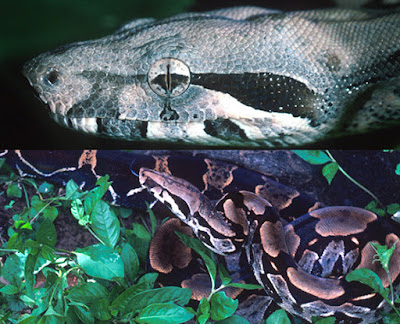Boa constrictor Linnaeus. 1758:215. Type locality: "India" (in error).
Boa imperator – Reinhardt and Lutken, 1862: 12.
Boa diviniloqua – Boulenger, 1893: 118.
Constrictor constrictor – Barbour, 1916b:223.
Constrictor (Boa) constrictor – Field, 1942:40.
Boa constrictor constrictor – Forcart, 1951: 199.
Constrictor constrictor constrictor –Underwood,1962: 179.
Boa c. constrictor – DeVerteuil, 1968: 101.
Distribution. Widespread, ranging from Colombia to northern Argentina, the Lesser Antilles, and Trinidad and Tobago. It is present in the Bocas on Monos Island, Gasparee Grande.
Size. 4 m TL, females larger than males, hatchlings about 0.6 m. Description. Nasals separated by at least four or five tiny internasals, a character that will readily distinguish it from all other snakes in the area. Upper labials number 16–25, lower labials number 20–28; these lack heat sensing pits found in Epicrates and Corallus. Smooth dorsal scales are in 76–95 rows; ventrals number 214–248; anal plate single; single subcaudals number 49–60. Dorsum tan or gray with dark red-brown transverse marking. Colors change posteriorly, tan areas become cream, or almost white, and brown transverse blotches become red. Brown stripe from snout passes through the eye and extends to first transverse band. Males have larger preanal spurs than females.
Life History. A habitat generalist: rainforest, secondary growth, savannas, and cultivated areas; often in close proximity to human habitations. Diet. A variety of vertebrates are eaten, including: rodents (squirrels, mice, rats, agouti), dogs, cats, marsupials, mongoose; birds; and reptiles (Ameiva, iguanas, tegu lizards). Reproduction. Courtship occurs in October-March; litters of 21–64 are born May-September.


No comments:
Post a Comment